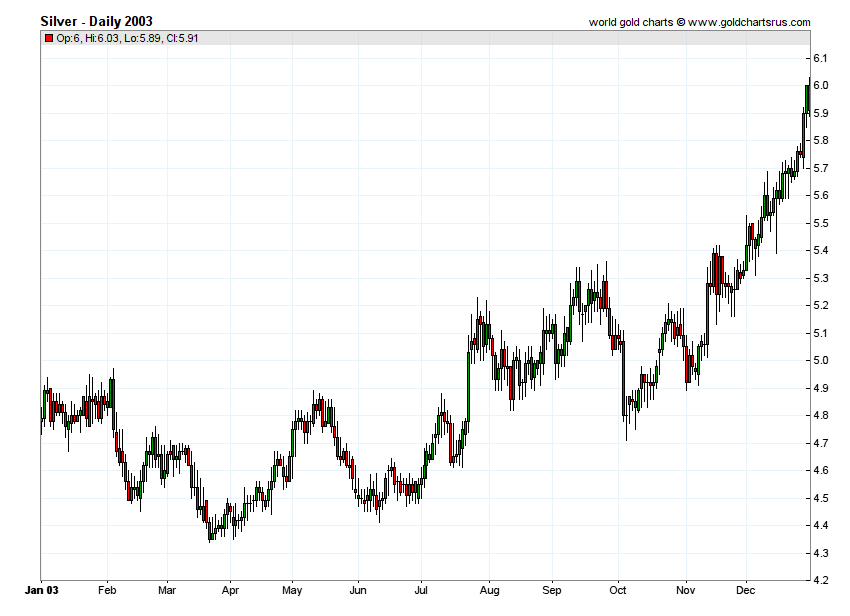In late 2003 I was visiting a very smart silver trader, with the shiny stuff around $4.10 and the conversation went from the most leveraged long we could think of to the trans-Pacific silver trade from Potosi and Mexico to China and thence to the valuation of China's currency and without even pausing for breath he said it was overpriced by 40%.Well, the silver trade worked out, but maybe not as well as I remembered. This chart from SD Bullion says silver never traded at $4.10 in 2003 and that, for the period in question, October, it was actually around $4.80:
That little tidbit made its way into the dusty old "If this happens then do this" file, along with the Tokyo earthquake plan* and the eruption of one of Iceland's big volcanoes at a Volcanic Explosivity Index of 6 or larger....

Fortunately Ag did crack $8.00 by the end of March 2004 but because of the higher entry price my fond memories of a double in the underlying didn't happen.
That's the funny thing about memory as you get older, the more recent the event the more prone to error, assuming the event has crossed the divide from short-term to long-term memory storage.
Potosi in 1575* on the other hand, I remember like it was yesterday.
From Aeon:
High in the Andes, Potosí supplied the world with silver, and in return reaped goods and peoples from Burma to Baghdad
In 1678, a Chaldean priest from Baghdad reached the Imperial Villa of Potosí, the world’s richest silver-mining camp and at the time the world’s highest city at more than 4,000 metres (13,100 feet) above sea level. A regional capital in the heart of the Bolivian Andes, Potosí remains – more than three and a half centuries later – a mining city today. Its baroque church towers stand watch as ore trucks rumble into town, hauling zinc and lead ores for export to Asia.....MUCH MORE
Elias al-Mûsili – or Don Elias of Mosul, as he was known – arrived in 17th-century Potosí with permission from Spain’s Queen Regent, Mariana of Austria, to collect alms for his embattled church. Potosí silver, Don Elias believed, would stave off the Sunni Ottomans and Shiite Safavids who battled for control of Iraq, periodically blasting Baghdad to smithereens with newly scaled-up gunpowder weapons. Just as worrisome to Don Elias were fellow Christians, schismatics with no ties to Rome.
The great red Cerro Rico or ‘Rich Hill’ towered over the city of Potosí. It had been mined since 1545 by drafted armies of native Andean men fuelled by coca leaves, maize beer and freeze-dried potatoes. When Don Elias arrived a century and a quarter later, the great boom of c1575-1635 – when Potosí alone produced nearly half the world’s silver – was over, but the mines were still yielding the precious metal.
By 1678, native workers were scarce and the output of the mines dwindling. Yet in the city’s royal mint, Don Elias marvelled at piles of ‘pieces of eight’, rough-hewn precursors of the American dollar, fashioned by enslaved African men. He saw them ‘heaped on the floor and being trampled underfoot like dirt that has no value’. For a long time, Potosí’s medieval technologies kept producing fortunes, if on a smaller scale.
On Potosí’s main market plaza, indigenous and African women served up maize beer, hot soup and yerba mate. Shops displayed the world’s finest silk and linen fabrics, Chinese porcelain, Venetian glassware, Russian leather goods, Japanese lacquerware, Flemish paintings and bestselling books in a dozen languages. Votive African ivories carved by Chinese artisans in Manila were especially coveted by the city’s most pious and wealthy women.
Pious or otherwise, wealthy women clicked Potosí’s cobbled streets in silver-heeled platform shoes, their gold earrings, chokers and bracelets studded with Indian diamonds and Burmese rubies. Colombian emeralds and Caribbean pearls were almost too common. Peninsular Spanish ‘foodies’ could savour imported almonds, capers, olives, arborio rice, saffron, and sweet and dry Castilian wines. Black pepper arrived from Sumatra and southwest India, cinnamon from Sri Lanka, cloves from Maluku and nutmeg from the Banda Islands. Jamaica provided allspice. Overloaded galleons spent months transporting these luxuries across the Pacific, Indian and Atlantic oceans. Plodding mule and llama trains carried them up to the lofty Imperial Villa.
Potosí supplied the world with silver, the lifeblood of trade and sinews of war – and as Don Elias knew, the surest means to propagate the Roman Catholic faith. In turn, the city consumed the world’s top commodities and manufactures. Merchants savoured the chance to trade their wares for hard, shimmering cash. The city’s dozen-plus notaries worked non-stop inventorying silver bars and sacks of pesos, loaded onto grumbling mules for the trans-Andean trek to the Pacific port of Arica or for the much longer four- to six-month haul south to Buenos Aires. In the rainy season rivers swelled, and in the dry season livestock died of thirst between scant watering holes....
*The Potosi - China connection was a pretty big deal with many scholars pinpointing the founding of the trading crossroads and entrepôt of the city of Manila in 1571 as the beginnings of trans-Pacific trade e.g.:
Born with a "Silver Spoon": The Origin of World Trade in 1571
Silver, Silk and Manila: Factors leading to the Manila Galleon Trade
“Path Dependence, Time Lags and the Birth of Globalisation:A Critique of O’Rourke and Williamson”